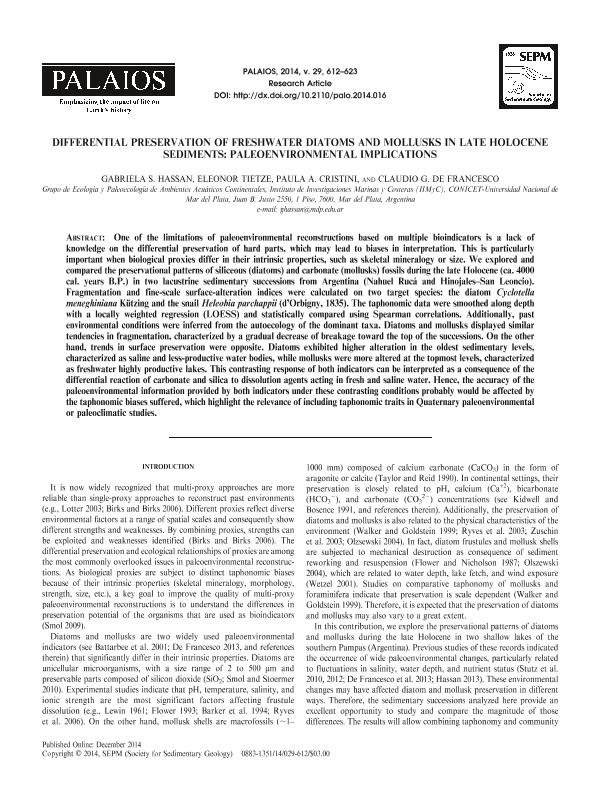Mostrar el registro sencillo del ítem
dc.contributor.author
Hassan, Gabriela Susana

dc.contributor.author
Tietze, Eleonor

dc.contributor.author
Cristini, Paula Andrea

dc.contributor.author
de Francesco, Claudio German

dc.date.available
2018-01-30T18:56:02Z
dc.date.issued
2014-10
dc.identifier.citation
Hassan, Gabriela Susana; Tietze, Eleonor; Cristini, Paula Andrea; de Francesco, Claudio German; Differential preservation of freshwater diatoms and mollusks in late Holocene sediments: paleoenvironmental implications; Society for Sedimentary Geology; Palaios; 29; 12; 10-2014; 612-623
dc.identifier.issn
0883-1351
dc.identifier.uri
http://hdl.handle.net/11336/35074
dc.description.abstract
One of the limitations of paleoenvironmental reconstructions based on multiple bioindicators is a lack of knowledge on the differential preservation of hard parts, which may lead to biases in interpretation. This is particularly important when biological proxies differ in their intrinsic properties, such as skeletal mineralogy or size. We explored and compared the preservational patterns of siliceous (diatoms) and carbonate (mollusks) fossils during the late Holocene (ca. 4000 cal. years B.P.) in two lacustrine sedimentary successions from Argentina (Nahuel Rucá and Hinojales–San Leoncio). Fragmentation and fine-scale surface-alteration indices were calculated on two target species: the diatom Cyclotella meneghiniana Kützing and the snail Heleobia parchappii (d'Orbigny, 1835). The taphonomic data were smoothed along depth with a locally weighted regression (LOESS) and statistically compared using Spearman correlations. Additionally, past environmental conditions were inferred from the autoecology of the dominant taxa. Diatoms and mollusks displayed similar tendencies in fragmentation, characterized by a gradual decrease of breakage toward the top of the successions. On the other hand, trends in surface preservation were opposite. Diatoms exhibited higher alteration in the oldest sedimentary levels, characterized as saline and less-productive water bodies, while mollusks were more altered at the topmost levels, characterized as freshwater highly productive lakes. This contrasting response of both indicators can be interpreted as a consequence of the differential reaction of carbonate and silica to dissolution agents acting in fresh and saline water. Hence, the accuracy of the paleoenvironmental information provided by both indicators under these contrasting conditions probably would be affected by the taphonomic biases suffered, which highlight the relevance of including taphonomic traits in Quaternary paleoenvironmental or paleoclimatic studies.
dc.format
application/pdf
dc.language.iso
eng
dc.publisher
Society for Sedimentary Geology

dc.rights
info:eu-repo/semantics/openAccess
dc.rights.uri
https://creativecommons.org/licenses/by-nc-sa/2.5/ar/
dc.subject
Comparative Taphonomy
dc.subject
Shallow Lakes
dc.subject
Quaternary
dc.subject
Dissolution
dc.subject.classification
Meteorología y Ciencias Atmosféricas

dc.subject.classification
Ciencias de la Tierra y relacionadas con el Medio Ambiente

dc.subject.classification
CIENCIAS NATURALES Y EXACTAS

dc.title
Differential preservation of freshwater diatoms and mollusks in late Holocene sediments: paleoenvironmental implications
dc.type
info:eu-repo/semantics/article
dc.type
info:ar-repo/semantics/artículo
dc.type
info:eu-repo/semantics/publishedVersion
dc.date.updated
2018-01-26T18:58:23Z
dc.journal.volume
29
dc.journal.number
12
dc.journal.pagination
612-623
dc.journal.pais
Estados Unidos

dc.journal.ciudad
Lawrence
dc.description.fil
Fil: Hassan, Gabriela Susana. Consejo Nacional de Investigaciones Científicas y Técnicas. Centro Científico Tecnológico Conicet - Mar del Plata. Instituto de Investigaciones Marinas y Costeras. Universidad Nacional de Mar del Plata. Facultad de Ciencia Exactas y Naturales. Instituto de Investigaciones Marinas y Costeras; Argentina
dc.description.fil
Fil: Tietze, Eleonor. Consejo Nacional de Investigaciones Científicas y Técnicas. Centro Científico Tecnológico Conicet - Mar del Plata. Instituto de Investigaciones Marinas y Costeras. Universidad Nacional de Mar del Plata. Facultad de Ciencia Exactas y Naturales. Instituto de Investigaciones Marinas y Costeras; Argentina
dc.description.fil
Fil: Cristini, Paula Andrea. Consejo Nacional de Investigaciones Científicas y Técnicas. Centro Científico Tecnológico Conicet - Mar del Plata. Instituto de Investigaciones Marinas y Costeras. Universidad Nacional de Mar del Plata. Facultad de Ciencia Exactas y Naturales. Instituto de Investigaciones Marinas y Costeras; Argentina
dc.description.fil
Fil: de Francesco, Claudio German. Consejo Nacional de Investigaciones Científicas y Técnicas. Centro Científico Tecnológico Conicet - Mar del Plata. Instituto de Investigaciones Marinas y Costeras. Universidad Nacional de Mar del Plata. Facultad de Ciencia Exactas y Naturales. Instituto de Investigaciones Marinas y Costeras; Argentina
dc.journal.title
Palaios

dc.relation.alternativeid
info:eu-repo/semantics/altIdentifier/doi/http://dx.doi.org/10.2110/palo.2014.016
dc.relation.alternativeid
info:eu-repo/semantics/altIdentifier/url/https://pubs.geoscienceworld.org/sepm/palaios/article-abstract/29/12/612/146369/differential-preservation-of-freshwater-diatoms?redirectedFrom=fulltext
Archivos asociados
